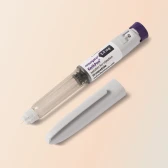Retatrutide is a new drug in development that’s getting a lot of attention. It’s turning heads for weight loss results, and it’s often nicknamed “triple G” because it acts on GLP-1, GIP and glucagon receptors. People lost around a quarter of their body weight within 48 weeks in early trials.
In the same trial, a group of participants with fatty liver saw large drops in liver fat, with many falling below 5%. That points to a possible role in fatty liver disease, though research is still ongoing.
In this article, we explain what the studies show so far, how it may work in the liver, and how its liver effects compare with existing weight-loss injections.
Key Takeaways
- Retatrutide reduced liver fat by 81-86% at higher doses (8mg and 12mg) in a 48-week phase 2 trial.
- 93% of people on the highest dose (12mg) achieved normal liver fat levels (<5%).
- Liver fat reductions tracked with weight loss and visceral fat loss.
- Most common side effects were mild to moderate digestive issues, more frequent at higher doses.
- Retatrutide is still in development and is not licensed in the UK or available outside clinical trials.
- Larger, longer studies are needed to confirm safety and effectiveness.

What is fatty liver disease (MASLD)?
MASLD stands for metabolic dysfunction-associated steatotic liver disease. You may also see NAFLD (non-alcoholic fatty liver disease) or simply fatty liver disease used for the same condition. It happens when too much fat builds up in the liver over time, affecting how the liver works.
It affects about one in five adults in the UK, and rates are rising with increasing levels of obesity. While it is often linked to excess weight, it can also occur in people with a healthy weight. The main risks include a large waist, type 2 diabetes, high cholesterol or blood pressure, a diet high in processed foods, and low physical activity.
In most people, MASLD causes no symptoms. But over time, excess liver fat can lead to inflammation and scarring (known as fibrosis), which in some cases may progress to cirrhosis. Losing 5–10% of body weight can significantly reduce liver fat and improve liver health.
How retatrutide works in the liver
When weight and blood sugar are off track, liver fat tends to build up. Retatrutide may help in several ways thanks to its triple action. Retatrutide works by targeting GLP-1, GIP and glucagon receptors.
GLP-1 and GIP help you feel less hungry and steady your blood sugar, which supports sustained weight loss. Glucagon adds something extra. It nudges the body to use stored fat for fuel and limit new fat build up.
In the 48-week trial, changes in liver fat tracked with drops in body weight and waist size, which fits this three-part effect.
What clinical studies show so far
In a phase 2 trial of retatrutide, a group of participants who started with at least 10% liver fat were followed for liver changes. Here's what was seen:
- Significant liver fat reduction with every dose. The higher doses (8 mg and 12 mg) led to an 81-86% average liver fat reduction by week 48.
- Many reached "normal" levels (<5%) of liver fat. With the 8 mg and 12 mg doses, 89% and 93% of participants achieved liver fat below 5% by week 48.
- Changes tracked with weight loss and waist size. Bigger liver-fat drops occurred alongside larger losses in body weight and waist circumference.
These results are promising for liver fat reduction, but they come from early-phase research. The trial was relatively small, included only US participants (mostly white), and didn't include people with type 2 diabetes or advanced liver scarring. It also ran for less than a year. Larger, longer studies are needed before it becomes a routine option for MASLD.
For now, retatrutide remains unlicensed in the UK and is not available outside clinical trials.
Does retatrutide help with visceral fat?
Early data suggest yes. Visceral fat is the deep abdominal fat that wraps around your internal organs. It's linked to insulin resistance and inflammation, two key drivers of MASLD.
In the phase 2 trial, retatrutide reduced visceral fat significantly at all doses. At 48 weeks, visceral fat dropped by 16.1% to 48.3% depending on the dose. Subcutaneous abdominal fat (the fat under your skin) also fell by 13.2% to 43.5%.
These reductions tracked closely with liver fat loss: when visceral fat fell, liver fat fell too.
Can retatrutide reverse fatty liver disease?
The short answer is we don’t know yet whether retatrutide can reverse fatty liver disease.
Early-stage MASLD (simple fat buildup with no scarring) can be fully reversed with weight loss and lifestyle changes. Retatrutide brought liver fat below 5% in 93% of people at 12mg dose, which is a good sign the liver is healing.
But true reversal means stopping inflammation and reversing fibrosis (liver scarring). This trial didn't include liver biopsies or people with advanced scarring, so we can't confirm whether structural liver damage improved.
For early MASLD, the data are promising. For advanced stages, retatrutide's role hasn't been studied yet.
Potential risks and safety profile
We can’t say for sure yet. Phase 3 studies are underway to confirm the full safety profile of retatrutide.
In the phase 2 trial, the most common retatrutide side effects were digestive: nausea, diarrhoea, vomiting, and constipation. These were more common at higher doses but were mostly mild to moderate. They're similar to what's seen with other weight loss injections like Wegovy and Mounjaro.
No serious liver-related safety issues were seen, but people with advanced liver disease were not included. Until larger trials include those populations, use in that context cannot be recommended.
Side effects support at Voy
"If you're using Voy and you experience any side effects, rest assured that our expert clinicians are just a message or phone call away. They can adjust your dose, prescribe medication to ease your symptoms, or simply offer reassurance.
Everyone responds differently to weight loss treatment and we'll help you find what feels right for you."

Retatrutide vs semaglutide and tirzepatide for fatty liver
Other GLP-1 medications like Wegovy and Mounjaro have shown promising liver results in trials. Wegovy is even FDA approved in the US for the more serious stage of fatty liver disease (MASH), where inflammation and scarring are present.
Retatrutide's 81-86% liver fat reduction (at higher doses) is striking and its glucagon activity may give it extra potency for fat metabolism compared to semaglutide or tirzepatide. But it was tested only in people with earlier-stage fatty liver disease, not advanced MASH.
Trials to directly compare these medications haven't been done yet, and retatrutide isn't licensed anywhere. If ongoing phase 3 trials confirm what we've seen so far, it could mark a real turning point for weight management and liver health.










